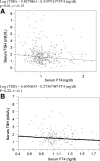Genetic predisposition to elevated serum thyrotropin is associated with exceptional longevity
- PMID: 19837933
- PMCID: PMC2795660
- DOI: 10.1210/jc.2009-0808
Genetic predisposition to elevated serum thyrotropin is associated with exceptional longevity
Abstract
Context: Exceptional longevity is associated with raised serum TSH.
Objective: The aim of this study was to examine whether offspring of people with exceptional longevity have elevated serum TSH and whether specific single nucleotide polymorphisms (SNPs) in the TSH-B gene and TSH receptor (TSHR) gene are associated with this phenotype.
Design/setting/patients: We measured serum TSH and free T(4) in Ashkenazi Jewish centenarians (n = 232; median age, 97 yr), their offspring (n = 366; median age, 69 yr), and age-matched controls without familial longevity (n = 163; median age, 70 yr). We determined TSH heritability, its distribution, and association with SNPs in the TSH-B and TSHR genes.
Results: Offspring had higher median serum TSH [1.68 mIU/liter (97.5% confidence interval, 0.65 to 4.79 mIU/liter)], compared to controls [1.50 mIU/liter (97.5% confidence interval, 0.63 to 3.93 mIU/liter); P = 0.02], with estimated heritability of 0.33 (P = 0.004). Allele frequency of two SNPs in the promoter/enhancer region of TSHR gene, associated with increased serum TSH, was higher in centenarians and their offspring compared to controls (rs10149689 G allele frequency, 0.57 and 0.53 vs. 0.48; P = 0.001 and P = 0.08; odds ratio, 1.56 and 1.22, respectively; and rs12050077 A allele frequency, 0.57 and 0.53 vs. 0.46; P = 0.0001 and P = 0.01; odds ratio, 1.68 and 1.32, respectively). Linkage disequilibrium between the two SNPs was high (r(2) = 0.95), suggesting interaction between them. Furthermore, GA haplotype frequency was significantly higher among centenarians and offspring compared to controls (0.57 and 0.53 vs. 0.46; P = 0.0001 and P = 0.01, respectively).
Conclusions: A heritable phenotype characterized by raised serum TSH is associated with human longevity. Carriers of rs12050077 and rs10149689 SNPs in the TSHR have higher serum TSH, possibly contributing to decreased thyroid function and longevity.
Figures





Comment in
-
Thyroid function and longevity: new insights into an old dilemma.J Clin Endocrinol Metab. 2009 Dec;94(12):4658-60. doi: 10.1210/jc.2009-2198. J Clin Endocrinol Metab. 2009. PMID: 19959751 No abstract available.
References
-
- Hollowell JG, Staehling NW, Flanders WD, Hannon WH, Gunter EW, Spencer CA, Braverman LE 2002 Serum TSH, T(4), and thyroid antibodies in the United States population (1988 to 1994): National Health and Nutrition Examination Survey (NHANES III). J Clin Endocrinol Metab 87:489–499 - PubMed
-
- Tietz NW, Shuey DF, Wekstein DR 1992 Laboratory values in fit aging individuals—sexagenarians through centenarians. Clin Chem 38:1167–1185 - PubMed
-
- Gussekloo J, van Exel E, de Craen AJ, Meinders AE, Frölich M, Westendorp RG 2004 Thyroid status, disability and cognitive function, and survival in old age. JAMA 292:2591–2599 - PubMed
-
- Surks MI, Hollowell JG 2007 Age-specific distribution of serum thyrotropin and antithyroid antibodies in the US population: implications for the prevalence of subclinical hypothyroidism. J Clin Endocrinol Metab 92:4575–4582 - PubMed
-
- Boucai L, Surks MI 2009 Reference limits of serum thyrotropin (TSH) and free thyroxine (free T4) are significantly influenced by race and age in an urban outpatient practice of medicine. Clin Endocrinol (Oxf) 70:788–793 - PubMed
Publication types
MeSH terms
Substances
Grants and funding
LinkOut - more resources
Full Text Sources
Molecular Biology Databases
Research Materials
Miscellaneous

